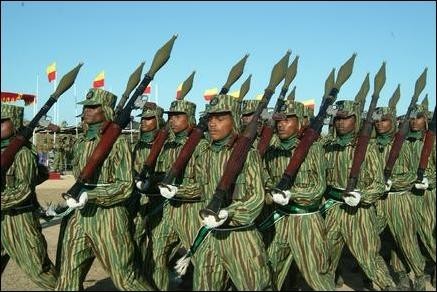
The civil wars between the Sri Lankan government and the Liberation Tigers of Tamil Eelam (LTTE) in Sri Lanka started in 1983. The smaller part of the population which consisted of several minor ethnicities, such as the Indian Tamils, Sri Lankan Tamils, Muslims and other smaller groups, were discriminated and treated harshly for a long period of time by the Sinhalese, which compose two thirds of the population, and rose up for equality. During the British colonization of the region, the Tamils were protected by the British, but after the Sri Lankan independence was achieved on the 4th of February 1948, they were no longer under their protection.
The origins of the civil war can be traced back to the 1920s. There were strong disagreements over language, access to educational institutions and constant clashes between the Sinhalese and the Tamils. These riots escalated completely in 1983, starting the Eelam War I, the first civil war. The “Sinhala Only Act” campaign of 1956 was a nationalistic, pro-Sinhalese act which privileged the Sinhalese and oppressed the Tamils and other minor ethnicities. It enforced a lot of new laws which the Sinhalese favored, including that the official state language was to be Sinhala and citizens with certain jobs had to speak the official language so they could further do this occupation. Many of the Tamils were unemployed due to their inability to speak the country’s official language. Ethnicities suffering from this act consider it to be the foundation of the civil wars that have occurred in our contemporary history.
Until the defeat of the LTTE in May 2009, the war cost more than 60,000 deaths. It has caused hundreds of thousands of people to flee from their homes, ending up in refugee camps, which do not have proper health or educational facilities. At the end of the war, about 300 thousand Internally Displaced People (IDPs) were in these camps, living in inhumane conditions. A major conflict is also the abuse and exploitation of children, as the LTTE started recruiting children to fight for them against the Sinhalese.
In 2002 a ceasefire was reached, but with that problem solved, a new one occurred: In 2005 about 890 thousand people lost their homes and 35 thousand were killed in the tsunami which unexpectedly hit the island. This drew international attention to the state, bringing aid from around the world and raising awareness to their critical situation. Sri Lanka was in extreme poverty and misery. The damage and influence that the constant fighting and the natural catastrophe had are still visible today; the infrastructure took severe damage and needs rebuilding, as do all the destroyed and damaged buildings and homes.
Even though the civil war is over, there are a few skirmishes every now and then between former LTTE fighters and the military, and due to the many years of distrust and hate towards one another, the atmosphere is still very tense. The government has worked towards a more peaceful and harmonious interaction between ethnicities and is also helping the about 8000 LTTE fighters who surrendered to the military forces to be integrated back into society. The country is slowly regenerating and repairing what has been destroyed during the long time of war, physically, mentally and socially.
Links:
Information on the situation:
http://www.unicef.org/srilanka/overview.html
http://www.zum.de/whkmla/sp/0809/kyungmook/kyungmook1.html
http://www.idsa.in/issuebrief/TheSituationinSriLankaAnUpdate
Information on the LTTE:
http://theterrorjournal.wordpress.com/2009/01/27/290/
Information on Sri Lanka:
https://www.cia.gov/library/publications/the-world-factbook/geos/ce.html
oxozzie liked this
lanab2405 liked this
notmee-uh liked this
coffee-sunflower liked this
fransgabb liked this
hayatelbereir liked this
studenttalks-blog reblogged this from model-united-nations-blog
 jmjul16 liked this
jmjul16 liked this pi3l0ver liked this
excellentia-et-studium liked this
themunteacher reblogged this from model-united-nations-blog
 lilithscavern liked this
lilithscavern liked this model-united-nations-blog posted this
